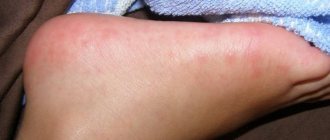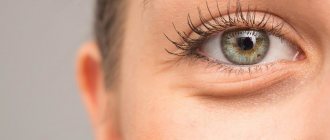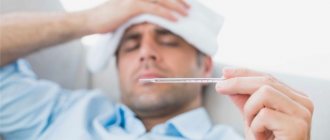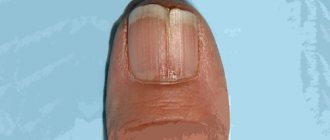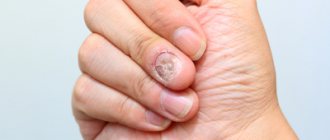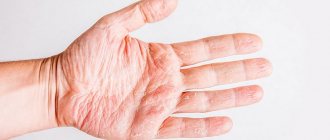Among various skin diseases, eczema is considered one of the most common. There are many factors that provoke the development of pathology. The treatment method for eczema is selected based on the cause that caused the disease.
Therapy is carried out using various medications and folk recipes. High therapeutic results are observed when using ointments. In this article we will look at how to choose the right ointment for eczema on your hands.
Causes of eczema
The exact cause of this condition is unknown, but the process is based on an overactive reaction of the body's immune system to an irritant or allergen. Substances are formed in the cells of the dermis that cause inflammation, which is associated with the main symptoms. It is also known that the tendency to this disease is inherited.
The therapy is aimed at suppressing inflammation and allergies, as well as healing, eliminating itching and dryness.
Topical medications are available in various forms. Each type of skin lesion has its own dosage form.
- Ointment - has a fatty base with which the medicine is mixed directly, it is more suitable for dry eczema and dermatitis on the hands, it cannot be used on wet areas, it may not be hormonal, or contain hormones. The active components penetrate the skin well, and the fat base itself is not absorbed.
- The cream contains water with a medicine dissolved in it, which is mixed with a fat base. Contains significantly less fat than ointment, so it is suitable for weeping eczema. It is better absorbed and does not leave greasy marks on clothes. The healing components of the cream penetrate the skin less well and usually act in its upper layers.
- In the paste, the concentration of dry substances is more than 25%.
- Lotion is a liquid dosage form (usually an aqueous solution of a drug plus oil). Lotions are suitable for wet conditions, as well as on the head under the hair.
Expert opinion
— The selection of hormonal/non-hormonal agents for external use is carried out by a specialist after collecting an anamnesis, identifying the causes that provoked the disease, and examination.
Firsakova Svetlana Sergeevna, dermatovenerologist, Melanoma Unit Moscow clinic
How to recognize eczema - diagnosis
You can recognize the symptoms of eczema by external signs, but to get a complete clinical picture, it is important to undergo a number of studies:
- general blood test, urine test;
- allergy tests;
- sowing tank
The results of the examination allow the dermatologist to identify the cause, make the correct diagnosis, and prescribe the necessary treatment. If there is a suspicion that eczema has developed against the background of chronic diseases, the doctor will prescribe additional tests and consultation with other specialized specialists (therapist, endocrinologist, gastroenterologist, psychotherapist, etc.).
Hormonal agents
All hormonal medications contain synthetic derivatives of the adrenal cortex. In a healthy body, they play the role of stress mediators and help adapt the functioning of all organs to changing conditions. Their ability to regulate immunity makes them very useful in many dermatological diseases in which inflammation and allergies play a role. Glucocorticoids affect the functioning of cells responsible for the inflammatory process. Thanks to this, chemical compounds that cause symptoms do not enter the bloodstream. Hormones enter the dermis layers and eliminate redness, swelling, itching, and rashes.
Hormone therapy is contraindicated in certain conditions:
- Rosacea
- Acne
- Viral diseases of the epithelium
- Skin infection caused by bacteria or fungi
- Reaction to vaccine administration
- Tuberculosis
- Scabies
- In pregnant women and children, these medications should not be applied to large areas of the body or covered with a bandage.
Advantan
A modern medicine that is well tolerated and has minimal negative effects. This ointment effectively helps relieve symptoms of psoriasis, eczema and dermatitis, and can be used on the arms and legs, as well as on the face. The drug practically does not enter the bloodstream; even after application over large areas, traces of this drug are not detected in the blood. Advantan is approved for people of any age. Expectant mothers should be treated with caution. Local side effects rarely occur with long-term therapy without medical supervision. This may include atrophy, redness and acne. Systemic adverse effects have not been described.
Hydrocortisone
It is based on the synthetic steroid hydrocortisone, one of the weakest glucocorticoids, with which it is better to start treating eczema. If the lesion covers a large area, the skin is severely damaged and is covered with a bandage, hydrocortisone is likely to enter the bloodstream and produce systemic effects.
Hydrocortisone can be treated from the age of two; it is prohibited during pregnancy.
Dermovate
This drug is the most powerful among pharmacological products with glucocorticoids. It is prescribed only in the most acute period, then switching to less powerful drugs. You should not use it for more than four weeks, as this may lead to side effects. At the same time, if the effect of therapy is not visible within several weeks, you need to recheck the diagnosis, because Dermovate shows extremely high effectiveness for eczema conditions.
Lokoid
Lokoid is a very strong glucocorticoid. It is effective for severe forms of atopy, but with prolonged use it causes serious atrophy of the skin, which sometimes persists even after discontinuation. Lokoid is absorbed into the bloodstream in small quantities, but systemic side effects, unlike local ones, easily go away after the end of the course. Pregnant women are allowed to be treated with Lokoid, using caution. Although it enters the bloodstream and through the placenta, a very short course of therapy is usually required, so there is no harmful effect on the fetus.
Lorinden
Loriden's formulation contains a powerful glucocorticoid combined with salicylic acid, which dissolves epithelial scales and helps the hormone penetrate deeper and work better, and also disinfects the skin in the area of application.
It is safe for children and expectant mothers only in small areas.
Prednisolone
This is a medium-strength remedy with which you can begin treating mild to moderate eczema. It easily penetrates the blood, so the course of treatment should be short, and during pregnancy it should be used carefully.
Soderm
This is an effective ointment for eczema on the skin, including the hands and face, is safe for use in adults and children, and patient reviews indicate that it is well tolerated. The active substance Soderma practically does not penetrate into the blood.
Flucinar
A highly active steroid with pronounced anti-inflammatory activity. Prescribed only for a short course due to local side effects. Since it enters the body, it can cause systemic complications and is contraindicated for pregnant women.
Fluorocort
Fluorocort has high activity, but is quite well tolerated. The result is achieved in 10 days, but if necessary, it is safe to use Fluorocort for up to 25 days.
Celestoderm-B
Contains an active and strong glucocorticoid, which effectively eliminates symptoms, but practically does not pass into the bloodstream. They also produce a combination cream with the addition of the antibiotic gentamicin, which suppresses the growth of microorganisms in the epidermis, but is contraindicated in children.
Cynacort
Cinacort contains the synthetic corticoid triamcinolone, which is well tolerated and has a pronounced anti-inflammatory effect. Suitable for dry eczematous changes, and the cream is suitable for swelling, weeping, as well as in skin folds and the border with the mucous membrane.
Elokom
A modern medicine with very strong anti-inflammatory and anti-allergic effects. It does not cause atrophy and does not enter the body. Due to its prolonged activity, it must be applied once a day. It can be used with caution by pregnant women.
Pills
Antihistamines
Histamine is an important component in the development of eczema symptoms. This is a compound that is produced by immune cells and enters the tissue during inflammation and allergies. Histamine is responsible for many manifestations of the pathological process, but mainly irritates the receptors, which leads to severe itching. Antihistamines are designed specifically to relieve these symptoms. They block histamine receptors and prevent it from showing its effect. These medications cause drowsiness, and the newer ones exhibit this effect to a lesser extent, but they also relieve symptoms to a lesser extent.
| First generation | Second generation |
| Suprastin | Claritin |
| Diphenhydramine | Loratadine |
| Tavegil | Zyrtec |
| Diazolin | Fenistil |
Antibacterial
Infections sometimes complicate the course of the disease, especially if there is oozing and the integrity of the epithelium is compromised. Then drugs are needed to treat microbial processes, which are often prescribed for eczema on the legs, because this area is more prone to infection. If local therapy is not enough, antibiotic tablets are used. If we take into account the characteristics of the microbiome of the body, the most suitable are penicillins, cephalosporins and macrolides, which are also quite gentle on their own microflora. But only a doctor should prescribe them; self-medication in this case is dangerous.
Non-hormonal ointments
The formula of non-hormonal anti-eczema pharmaceutical products includes various compounds that mitigate the symptoms of the disease. In some cases, using one of the non-hormonal ointments is sufficient to achieve remission. Combination medications are aimed at several components of the disease at once. They work well and have no systemic complications. Local adverse events vary depending on the formulation.
Akrustal
The active ingredient of this brand is solid oil. It helps with flaking, itching, and inflammation, although the exact mechanism by which it works is unclear. Solidol causes contact dermatitis, so upon first use it is necessary to test the reaction on a small area of the body surface. With prolonged use, oil acne appears due to the fact that solid oil clogs the ducts of the sebaceous glands. If such a reaction occurs, it is recommended to apply Akrustal every other day.
Boron-zinc-naphthalan ointment
This is a combination drug that is used for inflammatory diseases of the epithelium. Boric acid in its composition is an antiseptic. Zinc oxide dries and has an astringent effect, which is useful for weeping. Naftalan oil has a strong anti-inflammatory effect, relieves redness and itching, and cleanses the skin.
Heparin
Contains heparin, which resolves blood clots in the veins and improves blood flow. Thanks to auxiliary additives that dilate blood vessels in the dermis and increase tissue permeability, heparin is more easily distributed under the skin in the area of application. In addition, the composition includes a local anesthetic, which reduces itching, pain and the feeling of fullness. This ointment is useful against venous eczema, but is not effective against atopic eczema on the arms, face and torso.
Dermasan
This is a liquid with a very simple composition, which is used for dry skin, irritation and cracks. Glycerin softens and soothes, and ethyl alcohol destroys germs.
Levomekol
A combined drug that has a wound-healing effect and also fights bacteria that cause infection.
Losterine
A series of combined agents that have a good therapeutic effect for atopic dermatitis. A unique component of the Losterin series is naftalan oil, a powerful anti-inflammatory agent that soothes irritation, reduces swelling, itching and redness, and promotes healing. In addition, among the active ingredients are urea, which is a good emollient, salicylic acid (softens and exfoliates), D-panthenol and almond oil.
Methyluracil
Methyluracil enhances metabolism in epithelial cells, stimulates their division and promotes regeneration.
Radevit
The working components of Radevit are vitamins A, E and D. Vitamin A promotes the renewal of epithelial cells. Vitamin E is an excellent antioxidant. Vitamin D fights inflammation and improves cell nutrition.
Salicylic
Salicylic acid softens scales and helps cleanse the skin in case of eczematous lesions. It also regulates the functioning of the sebaceous and sweat glands, which is useful for seborrheic dermatitis. Thanks to its antiseptic properties, it prevents infection of epidermal lesions. Contraindicated for children.
Skin Cap
Skin Cap cream and shampoo contain the therapeutic component zinc pyrithione. The main direction of Skin Cap's work is anti-inflammatory. It softens the epithelium, eliminates itching and flaking. Active against fungi that support inflammation and flaking in seborrheic dermatitis. Zinc pyrithione also fights bacteria that complicate eczema.
Solipsor
Solipsor products contain medical grease and birch tar, which fight inflammatory manifestations, and natural herbal extracts soothe, eliminate itching, and destroy microorganisms. Solidol sometimes provokes contact dermatitis, so for the first time Solipsor should be tried on a small area.
Thymogen
Thymogen regulates cell renewal, stimulates tissue regeneration and healing.
Zinc paste
Having drying and astringent activity, zinc paste makes it easier to get wet.
Elidel
A highly effective medicine, comparable in strength to hormones. Elidel, penetrating into the dermis, inhibits the division of immune cells responsible for the formation of inflammation and blocks the release of allergy mediators. Elidel does not cause atrophy, does not affect general immunity (even when taken orally, in the form of tablets), and does not reduce resistance to infections. Approved for children from 3 months of age, but not yet sufficiently studied during pregnancy. Adverse reactions such as infection at the site of application are rare with very long-term use.
Emolium
This is a line with significant moisturizing activity. Emulsion Emolium contains natural oils, urea, paraffin oil and other emollients, that is, substances that help the body retain moisture as much as possible.
Eplan
Contains a solution of lanthanes in glycerin - the active Glycolan complex, which promotes skin regeneration and rapid healing of damage, and also prevents infection.
The role of vitamins
Vitamin A
Retinoids, a group of substances derived from vitamin A, are not first-line pharmaceuticals for the treatment of eczema. However, their effects on the skin make these chemical compounds potentially useful for dermatological problems. Retinol binds to special receptors in the nuclei and thereby controls the process of differentiation of skin cells (the formation of various specialized cells from one stem cell), and also suppresses division and stimulates apoptosis - programmed (non-pathological) cell death. Studies have shown that retinoids are effective in treating severe forms of eczema when hormonal treatments have not had the expected effect. First, creams with these substances are prescribed, but if remission cannot be achieved, retinoid tablets are used. The negative effect on the fetus, which may result in developmental defects, makes retinoids inapplicable during pregnancy and breastfeeding. Women of childbearing age should use vitamin A supplements with the greatest caution. But of course, daily intake of vitamin A in a small dose is not dangerous, but only brings benefits for skin health.
B vitamins
Insufficiency of B vitamins is one of the risk factors for the development of eczema. It is useful to take vitamin complexes, and vitamins B5 and B12 are included in ointments.
| B3 (niacin) | Essential for hormone production, detoxification, and also helps the body synthesize energy from carbohydrates and form fats. This is not the fat that is deposited in the subcutaneous tissue and contributes to weight gain, but healthy sebum that protects the skin and prevents it from losing moisture. This substance also helps fight stress, insomnia, and neuroticism, which contribute to the development of eczema. |
| B5 (pantothenic acid) | It also helps form essential fats, rids the body of toxins, regulates immunity and participates in the synthesis of hormones. All of these features are beneficial for eczema. |
| B6 (pyridoxine) | Helps process amino acids - the building blocks for protein synthesis, including collagen, the main structural protein of the skin |
| Para-aminobutyric acid | An antioxidant that fights free radicals, helps build red blood cells, and maintains healthy intestinal microflora. |
| B12 (cyanocobalamin) | Actively binds nitric oxide in the dermis. Nitric oxide under normal conditions has an anti-inflammatory effect, but with eczema its production increases sharply, and on the contrary, it acts as a mediator of inflammation. Nitric oxide is associated with local redness and itching. Cyanocobalamin, when applied to the skin, eliminates these symptoms. |
| B7 (biotin) | Promotes the regeneration of new cells, supports the normal functioning of the sebaceous glands, which protect the epithelium, and also balances blood sugar. |
Vitamin C
This substance plays a key role in maintaining skin health. Ascorbic acid is not produced in the body, and dietary intake is the only source of this vitamin. Once inside, it is distributed in tissues, including high concentrations in the outer layer of the skin - the epidermis. There it regulates cell division, melanin formation, and fights oxidative stress. This vitamin helps maintain the barrier function of the body. It is also an important element in the formation of collagen, a protein that ensures the integrity of the dermis. Acting as an oxidant and at the same time an antioxidant, it controls the balance of oxidized substances in the skin, suppresses free radicals and fights aging. In patients with atopic eczema, it significantly reduces the intensity of the inflammatory process, and also restores the barrier and prevents moisture loss due to the active synthesis of ceramides. It works both when taken orally and as part of topical preparations, but in this case the concentration must be high enough to break through the outer layers of the epidermis.
Vitamin E
An essential nutrient thought to have effects on the immune system and exhibit antioxidant properties. Studies have shown that vitamin E is effective against itching, redness, swelling, loss of skin integrity and thickening of the epithelium. However, this effect lasted only three months after the end of therapy, with a large number of patients experiencing a return of symptoms. Tocopherol is good to use occasionally, as needed, it helps to remove it during the manifestation of the disease.
Among the undesirable effects, increased itching, contact dermatitis, and burning are noted; they occur very rarely.
Side effects
Complications from medicinal products containing glucocorticoids in the area of their application are associated with their effect on cell repair.
- Atrophy. At the site of application, the epidermis becomes thin, dull, easily damaged, and loses hair.
- Decreased protective function of the body. Acne appears and infection easily develops.
In some cases, the hormone contained in the drug mixture can enter the bloodstream and cause a systemic complication. Glucocorticoids affect blood pressure, sugar levels, lead to a significant decrease in immunity, obesity, osteoporosis, and cause growth retardation in children. To prevent hormones from causing such disorders, they should only be used under medical supervision. The doctor will give recommendations on how long and how often to apply the ointment for eczema, depending on whether the area of application is on the arms, legs or body, will help reduce the dose or change treatment in time and, of course, will tell you the name of the most suitable drug for this case.
Side effects of non-hormonal ointments manifest themselves in the form of irritation or an allergic reaction. Medical solid oil in some medications provokes the appearance of contact dermatitis.
Correction of gastrointestinal disorders and antibiotic therapy for eczema
Correction of the functioning of the gastrointestinal tract involves the prescription of enzyme preparations (Pancreatin, Mezim, Enzistal, Festal, Creon). In some situations, taking medications may last for several months. In some cases, the use of lactulose (Portalac, Duphalac) is indicated. When dysbacteriosis is diagnosed, Bifiform, Linex, and Hilak Forte are prescribed. It is also recommended to include fermented milk products in your diet, which help fight this problem.
Antibacterial drugs are represented by broad-spectrum antibiotics (cefotaxime, amoxiclav, ceftriaxone). Antibacterial agents are prescribed when a secondary infection develops or if the eczema is microbial in nature. Antibiotics are recommended to be used by injection.
Prevention
For prevention, two types of care products are used.
- Moisturizing products with powerful emollients, such as urea and glycerin, soften and prevent the body from drying out due to the fact that, distributed in the outer layers of the epidermis, they attract moisture. They are applied throughout the day as needed.
- Natural oils, waxes and silicones create a protective barrier on the surface of the skin, preventing moisture evaporation. They are best used after a shower and applied to a damp area of the body.
Inexpensive and cheap ointments and creams for eczema
Treatment of eczema requires constant use of ointments and creams. This can be a significant blow to the budget. Among the drugs offered, it is possible to choose inexpensive drugs that are effective in combating the disease.
| Title, description | Price |
| Salicylic ointment. It relieves the main symptoms well and quickly. Is safe and effective | 20 rub. |
| Zinc ointment. Effective against all types of skin lesions. | 20 rub. |
| Baby cream. Helps soften the skin after using medications. | 20 rub. |
| Prednisolone. Hormonal ointment. Allowed to be used after a doctor's prescription. | 20 rub. |
| Vishnevsky ointment. Effectively relieves inflammation. Has a detrimental effect on pathogenic microflora. | 30 RUR |
Bibliography
- Akhtyamov, S.N. Practical dermatocosmetology / S.N. Akhtyamov, Yu.S. Butov. M.: Medicine, 2003. - 391 p.
- Arkhangelskaya, E.I. Materials on the clinic, etiology and pathogenesis of diffuse streptoderma and microbial eczema: abstract. dis. Dr. med. Sciences / E.I. Arkhangelskaya. L., 1973. - 38 p.
- Aizikovich, JI.A. Abstracts of scientific works of the VIII All-Russian Congress of Dermatovenerologists / JI.A. Aizikovich, T.V. Sokolova. 4.1. // Dermatology. - 2001.- P. 205.
- Buxton, P.K. Dermatology / P.K. Buxton. M.: Publishing house BINOM, 2005, - 175 p.
- Belousova, T.A. Neurogenic factors in the pathogenesis of eczema: abstract. dis. . Ph.D. honey. Sciences/T.A. Belousova. M., 1984. - 18 p.
- Demidova, M.A. Epidemiological and pharmacoeconomic aspects of the use of antihistamines in the treatment of patients with eczema / M.A. Demidova, E.V. Bogdanova // Ross. magazine skin and venereal diseases. 2009. - No. 2. — P. 46-49.
- Kudryavtseva, E.V. Lokoid and modern approaches to external therapy of atopic dermatitis / E.V. Kudryavtseva, AB Karaulov // Immunopathology, allergology, infectology. 2003. - No. 4. — P. 57-62.
- Mikhailenko, A.A. Allergy and allergic diseases /AA Mikhailepko, G.A. Bazanov. M.: Med. information agency, 2009. - 304 p. thirty.
- Prokhorenkov, V.I. Eczema / V.I. Prokhorenkov, T.A. Yakovlev 3rd ed. - Krasnoyarsk: PIK "Offset", 1994. - 255 p.
Drug treatment for weeping eczema
Eczema is treated with medication through systemic and local treatment. Systemic medications are taken for the purpose of therapeutic effects in the following areas:
- Correction of the immune system;
- Antibacterial therapy;
- Reducing sensitization (the body's susceptibility to allergens);
- Strengthening of vascular walls (angioprotection);
- Symptomatic therapy;
- Reduction of intoxication syndrome;
- Correction of disorders of the gastrointestinal tract;
- Sedative therapy;
- Reducing the severity of inflammatory manifestations with the help of non-steroidal, steroidal and antihistamine drugs.
External therapy for eczematous disease is carried out with the aim of eliminating the pathological manifestations of the disease, restoring regenerative processes in tissues and combating pathogens.
Physiotherapy and local therapy for eczema
As local therapy, lotions with a solution of tannin, dioxidine, silver nitrate, furatsilin, methylene blue, potassium permanganate, boric acid and resorcinol can be prescribed. It is also possible to use ointments that contain steroid hormones, combined creams (Akriderm, Triderm), aerosols Aekol and panthenol. However, local drugs should be prescribed only after the oozing of eczematous inflammation has decreased.
Physiotherapeutic techniques include sunbathing, selective phototherapy, aerosol therapy, ultraviolet irradiation, phonophoresis with glucocorticosteroids and antihistamines. The appropriateness of a particular procedure is determined by the doctor, taking into account the nature and severity of the disease, as well as the presence of possible contraindications that are identified during the preliminary examination.
Features of the way of life with eczema
The main direction of therapy for eczematous disease is to avoid contact with provoking factors and allergens that caused the development of the disease. During the period of exacerbation of the pathology, the patient should avoid drinking alcohol and quit smoking. You should wear cotton clothes without bright colors, remove bracelets, chains and other jewelry in the area where the lesions are located. An allergic reaction to chromium and nickel (the main components of metal accessories) can lead to the formation of eczematous inflammation.
The use of colognes, perfumes, deodorants and creams (except those prescribed by a doctor) should also be avoided during an exacerbation of the disease. The patient must notify the doctor about all medications, decoctions and infusions that he uses as prescribed by other doctors or on the advice of friends. You should also exclude various synthetic detergents (washing powders, gels, shampoos, etc.) from everyday use. If the disease is microbial, it is recommended to use soap without fragrances or dyes. In the true form of eczematous disease, water procedures are undesirable. The patient should also limit emotional and physical overload, follow a sleep and rest schedule, adhere to hygiene rules and eat right, which will help maintain the proper functioning of the gastrointestinal tract.
It should be remembered that the use of folk remedies does not help eliminate the provoking factors for the development and exacerbation of eczema. Their use only makes it possible to alleviate the symptomatic manifestations of the disease and reduce the inflammatory process. Only a qualified doctor can prescribe complex effective therapy after assessing the clinical picture of the disease and the patient’s health condition. You can consult with an experienced specialist and undergo a course of treatment using modern therapeutic techniques in our clinic. An individual approach to each patient and high professionalism of the medical staff will ensure successful and safe treatment of wet eczema.
Attention!
This article is posted for informational purposes only and under no circumstances constitutes scientific material or medical advice and should not serve as a substitute for an in-person consultation with a professional physician.
For diagnostics, diagnosis and treatment, contact qualified doctors! Number of reads: 6721 Date of publication: 09/29/2018
Dermatologists - search service and appointment with dermatologists in Moscow
Types and stages of the disease
Regardless of the location, weeping eczema goes through several stages of development:
- The appearance of vesicles with a diameter of up to 5 mm, reminiscent of bubbles when water boils.
- Formation of erosions at the site of opened blisters, which burst due to scratching or on their own.
- The formation of wet areas covered with serous fluid, which is released from the burst vesicles.
- Transition of the disease to the dry stage with a decrease in redness and weeping, the formation and rejection of scales.
Symptoms and features of the course
Symptoms and treatment of weeping eczema are interrelated, since therapy is selected taking into account the manifestations of the disease. It begins with redness of the skin. Subsequently, the inflamed areas swell and become covered with itchy blisters - vesicles. The itching can be so severe that it can cause insomnia and even nervous breakdowns.
Wet eczema on the head or other parts of the body spreads very quickly. The vesicles burst, releasing serous exudate. This causes the formation of weeping areas on the skin. Over time, they dry out and become covered with grayish, rough crusts. When the lesions heal, pigmented areas remain in their place. They are darker in color than healthy skin.
The peculiarity of the treatment of weeping eczema in humans is that with this form of the disease, symptoms of different stages are simultaneously present on the skin:
- bubble elements;
- weeping erosion;
- scaly lesions.
The disease becomes chronic over time. Eczema can last for years, periodically exacerbating and subside. Each time, relapses become more severe, and in advanced cases, secondary infections occur.

